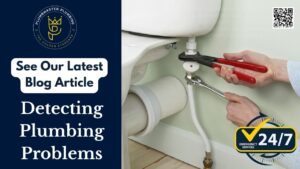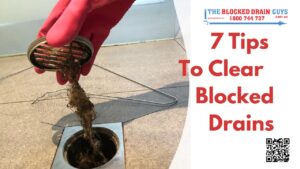How Do You Know When To Call A Plumber?
Are you experiencing mysterious leaks, clogged drains, or leaking taps in your Sydney home? Plumbing problems can be frustrating and disruptive, but detecting them early can save you from costly repairs and potential damage to your property.
No worries, folks. We will guide you on how to detect common plumbing problems and provide practical solutions to address them.
When it comes to detecting plumbing problems, it’s important to pay attention to subtle signs that may indicate an issue. Keep an eye out for water stains or dampness on walls or ceilings, as this could be a sign of a hidden leak. Also, if you notice a reduction in water pressure or an unusual gurgling sound when using your fixtures, it may indicate a clogged drain.
By being proactive and observant, you can catch these problems before they escalate into major issues. Stay tuned as we explore common plumbing problems and provide you with the knowledge to tackle them head-on, ensuring a well-functioning, leak-free home.
<span data-preserver-spaces="true">Key Takeaways</span>
- Detecting plumbing problems early is crucial to prevent costly repairs and property damage.
- Subtle signs of plumbing issues include water stains, dampness on walls or ceilings, decreased water pressure, and unusual sounds.
- Shower leaks can cause water damage and mould growth and can be detected by checking for visible signs of leakage, inspecting the showerhead, faucet, and visible pipes, listening for sounds of running water, and conducting a dye test.
- Clogged drains can be identified by slow drainage and foul odours and can be addressed using a plunger or drain snake. Prevention measures include avoiding pouring grease or oil down the drain, using a drain strainer, and periodically flushing drains with hot water. If the problem persists, search for plumbers near me through Google or ask friends for recommendations.
Problem: Shower Leak
So you’ve got a shower leak? Don’t let your worries go down the drain; tackle this drip before it becomes a flood!
Detecting a shower leak is crucial to prevent water damage and potential mould growth. Steps to take:
- Check for visible signs of leakage, such as water stains on the ceiling below the bathroom or dampness around the shower area.
- Inspect the showerhead, faucet, and any visible pipes for any signs of dripping or water accumulation. If you notice any water pooling or a constant drip, it’s time to take action.
- To further investigate the issue, turn off all the water sources in your home and listen for any sounds of running water. There may be a hidden leak if you hear a faint hissing or rushing noise near the shower.
Once you’ve identified the source of the leak, it’s important to address it promptly. If it’s a minor issue like a loose connection or a worn-out gasket, you can fix it using basic plumbing tools. However, it’s best to call a professional plumber if you’re unsure about the cause or if the leak seems significant. They have the expertise and equipment to diagnose the problem and provide the necessary repairs accurately.
Remember, taking care of a shower leak saves you from costly water damage and ensures a safe and comfortable showering experience for years to come.
Problem: Clogged Drain
Experiencing a clogged drain again? Let’s explore how to identify and address this common plumbing issue.
Dealing with a clogged drain on your own can be annoying and tricky, which is why asking for professional help is encouraged.
Signs to look for:
- The first sign of a clogged drain is usually slow drainage. If you notice that water is taking longer than usual to empty from your sink or shower, it may indicate a blockage in the pipes.
- A foul odour coming from the drain is another telltale sign of a clog. If you detect any of these signs, taking action before the problem worsens is important.
To avoid a clogged drain, you can try a few methods.
- One of the simplest ways is to use a plunger. Ensure enough water is in the sink or tub to cover the plunger, then place it over the drain and push it down firmly. Give it a few quick pumps to create suction, and then pull up sharply. This action can help dislodge the clog and restore proper drainage.
- Another way is to insert and twist the snake in the drain while pushing forward. This can help break up the clog and allow water to flow freely again.
Prevention is key when it comes to clogged drains. Prevent blockages by refraining from pouring grease or oil down the drain because they can solidify. Utilise a drain strainer to catch hair and other debris that could potentially clog the pipes. It’s also a good idea to periodically flush your drains with hot water to help prevent build-up.
However, if the drain clogs repeatedly even after trying these tips, you better ask Google for plumbers near me, your ultimate solution for a clogged drain.
By following these tips, you’ll be able to maintain a happy, functioning plumbing system and enjoy a clog-free home.
Problem: Leaking Taps
If water is dripping steadily from your taps, it’s time to address the problem of leaking taps. Leaking taps not only waste water but can also lead to higher water bills and potential damage to your plumbing fixtures.
Leaking taps can be caused by a variety of issues, such as worn-out washers, faulty seals, or loose connections. Ignoring these leaks can result in more serious plumbing problems down the line.
In addition to wasting water, the constant dripping can promote the growth of mould and can lead to unpleasant odours and even health issues for you and your family. Calling a plumber when you notice a leak can save water from wasting and prevent potential damage to your home’s infrastructure.
Don’t delay in addressing this issue, as the longer you wait, the more extensive and costly the repairs may become.
Noticed one of these Silent Plumbing Signs in your Sydney home?
Don’t ignore these silent signs in your Sydney home – they could be indicative of underlying plumbing issues. While some plumbing problems may be obvious, like a burst pipe or a leaking faucet, other signs may go unnoticed but shouldn’t be ignored.
These silent signs can be early indicators of larger plumbing problems that could lead to costly repairs if left unattended.
- One silent sign to watch out for is low water pressure. If you notice that the water pressure in your faucets or showerheads has significantly decreased, it could be a sign of a plumbing issue. This could be caused by a clog in the pipes, mineral build-up, or even a problem with the main water supply line. It’s important to address this issue promptly to prevent further damage and ensure proper water flow throughout your home.
- Another silent sign to pay attention to is a sudden increase in your water bill. If you haven’t been using more water than usual but notice a significant spike in your bill, it could be a red flag for an undetected plumbing problem. This could be due to a hidden leak in your pipes, which can waste a substantial amount of water and increase your expenses.
- Banging or knocking sounds when turning on or off the water can indicate issues with your pipes, such as air trapped in the system or loose fittings. Ignoring these sounds could lead to more severe plumbing problems down the line. If you hear any unusual noises, having a professional plumber inspect your system and address the issue before it escalates is best.
By paying attention to these silent signs in your Sydney home, you can catch plumbing problems early and prevent them from becoming major headaches.
Don’t hesitate to seek professional help if you notice any of these signs, as addressing the issue promptly can save you time, money, and unnecessary stress.
What to Do in a Plumbing Emergency?
When faced with a plumbing emergency, reach out to a professional plumber for immediate assistance. Plumbing emergencies can be stressful and overwhelming, but having a reliable plumber by your side can provide the expertise and quick resolution you need.
Here are three important steps to take during a plumbing emergency:
1. Stay calm and assess the situation: The first thing to do is to remain calm and assess the severity of the problem. Is there a burst pipe flooding your home? Is there a major leak causing water damage? Understanding the extent of the issue will help you communicate effectively with the plumber when you call for help.
2. Shut off the water supply: In most plumbing emergencies, turning off the main water supply is crucial to prevent further damage. Find the main shut-off valve and turn it clockwise to stop the flow of water. This will help minimise potential flooding and allow the plumber to fix the problem without additional complications.
3. Call a professional plumber: Don’t attempt to fix a plumbing emergency on your own, as it may worsen the situation. Instead, reach out to a professional plumber who specialises in emergency repairs. Make sure to provide them with all the relevant details about the problem so they can come prepared.
Remember, during a plumbing emergency, time is of the essence. By reaching out to a professional plumber, staying calm, shutting off the water supply, and letting the experts do their job, you can ensure a swift and successful resolution to your plumbing emergency.
Look no further than Plumbmaster Plumbing, your trusted local plumbers!
Whether you have a leaky shower head, a blocked toilet, or any other plumbing problem, our team of experts is here to help. With years of experience and a commitment to exceptional service, we guarantee to fix your plumbing issues swiftly and effectively.
Don’t let those leaks ruin your day – call us now and experience the difference of having reliable plumbers at your service. Trust us to keep your Sydney home’s plumbing in top shape!
https://www.plumbmasterplumbing.com.au/
The Article How To Detect When You Have A Plumbing Problem? First Appeared ON
: https://ad4sc.com



Comments are closed